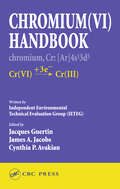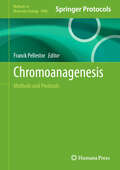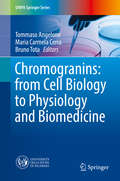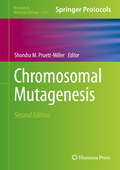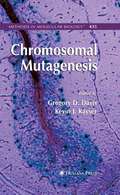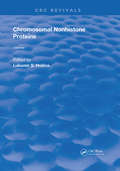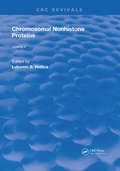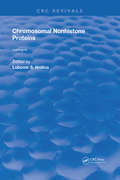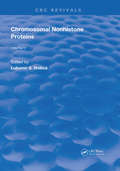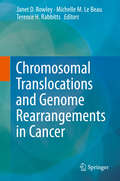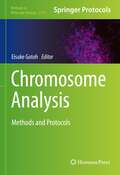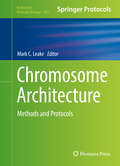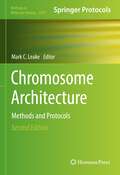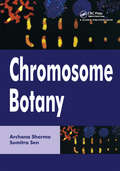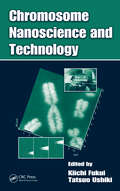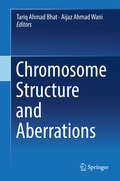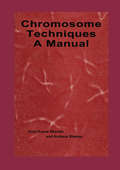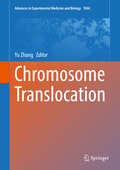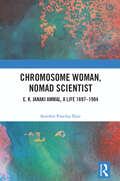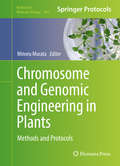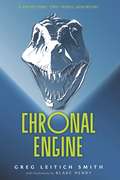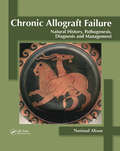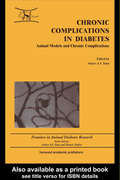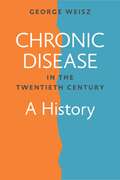- Table View
- List View
Chromium(VI) Handbook
by James A. Jacobs Jacques Guertin Cynthia P. AvakianPut together by a team of scientists, engineers, regulators, and lawyers, the Chromium(VI) Handbook consolidates the latest literature on this topic. The broad scope of this book fills the need for a comprehensive resource on chromium(VI), improving the knowledge of this contaminant at a time when the extent and degree of the problem is still being
Chromoanagenesis: Methods and Protocols (Methods in Molecular Biology #2968)
by Franck PellestorThis extensive volume explores the phenomena of chaotic genomic rearrangements, known as chromoanagenesis, their formation mechanisms, and the state-of-the-art techniques used to detect them. The book delves into the potential impact of chromoanagenesis on cancers and congenital diseases, as well as its broader implications for genomic evolution and human health through a variety of cutting-edge methodologies. Written for the highly successful Methods in Molecular Biology series, most chapters include introductions to their respective topics, lists of the necessary materials and reagents, step-by-step and readily reproducible laboratory protocols, and tips for troubleshooting and avoiding known pitfalls. Authoritative and comprehensive, Chromoanagenesis: Methods and Protocols serves as an ideal guide to the mechanisms and consequences of chromoanagenesis and a resource for researchers and clinicians seeking to explore the cutting-edge techniques and models used to study this phenomenon.
Chromogranins: from Cell Biology to Physiology and Biomedicine (UNIPA Springer Series)
by Tommaso Angelone Maria Carmela Cerra Bruno TotaThe volume is designed to provide an integrated overview of the results from the last fifteen years of research on Chromogranins in relation to cell biology, physiology and biomedicine. The different chapters highlight novel activities of these proteins, including their role in granule biogenesis, hormone co-storage, stimulus-processing-secretion coupling, autonomic sympathetic/parasympathetic balance, immune and cardiocirculatory function, and the response to stress. Biomedical aspects are also illustrated with focus on the prognostic and diagnostic significance of Chromogranin in the presence of tumors, cardiovascular diseases and inflammatory conditions. The volume is of interest for laboratory and clinical scientists, PhD and Post-doc students that will be inspired to go deep inside the molecular, biochemical, physiological, pharmacological and clinical aspects of these fascinating multifaceted proteins.
Chromosomal Instability in Cancer Cells (Recent Results in Cancer Research #200)
by Thomas Ried B. Michael GhadimiThis issue of Recent Results in Cancer Research presents a comprehensive review of current understanding of chromosomal instability in cancer and of strategies to use this information for better treatment of patients with cancer. Cancer is a disease of the chromosomes, and chromosomal instability in cancer disrupts gene function by either inactivating tumor suppressor genes or activating growth-promoting oncogenes. The chromosomal basis for these aberrations is either translocations, which change the integrity of genes, or abnormal numbers of chromosomes, a condition referred to as aneuploidy, which results in abnormal gene expression levels. Such structural or numerical chromosomal aberrations are specific for distinct tumor entities. The degree of chromosomal instability and the degree of intratumor heterogeneity have profound consequences for disease outcome and for therapeutic stratification.
Chromosomal Mutagenesis (Methods in Molecular Biology #1239)
by Shondra M. Pruett-MillerThis new edition explores current and emerging mutagenesis methods focusing specifically on mammalian systems and commonly used model organisms through comprehensive coverage and detailed protocols. Since the first edition, major advances and discoveries have made chromosomal mutagenesis a widely used technique and one that is available to any molecular biology laboratory, and this collection provides detailed protocols, case-studies, and reviews from thought-leaders in the field. Written in the highly successful Methods in Molecular Biology series format, chapters include introductions to their respective topics, lists of the necessary materials and reagents, step-by-step, readily reproducible laboratory protocols, and tips on troubleshooting and avoiding known pitfalls. Authoritative and fully updated, Chromosomal Mutagenesis, Second Edition aims to help speed scientific discovery and aid in the next advances in the field.
Chromosomal Mutagenesis (Methods in Molecular Biology #435)
by Kevin J. Kayser Greg DavisGreat disparities exist between organisms with regard to the relative ease of chromosomal mutagenesis and manipulation. In Chromosomal Mutagenesis, a team of experts provide a variety of chromosomal manipulation techniques, including insertional gene disruptions, gene knockouts, stimulated homologous recombination techniques and other novel tools, for both prokaryotic and eukaryotic organisms, and attempt to expand the genetic toolbox beyond model organisms. Following the format of the highly successful Methods in Molecular BiologyTM format, each chapter offers step-by-step laboratory instructions, lists of the necessary equipment and reagents, and tips on troubleshooting and avoiding known pitfalls. Comprehensive and cutting-edge, Chromosomal Mutagenesis covers state-of-the-art techniques that are staged to expand, if not revolutionize, genetic analysis in the long neglected and relevant cell types.
Chromosomal Nonhistone Protein: Volume I: Biology
by L. S. HnilicaThe first volume of the Chromosomal Nonhistone Proteins treatise presents a summary of the many attempts in the literature to correlate changes in chromosomal histone proteins specificity and metabolism with transcriptional regulations in eukaryotic cells.
Chromosomal Nonhistone Protein: Volume II: Immunology
by L. S. HnilicaThe second volume of the Chromosomal Nonhistone Proteins treatise is dedicated in its entirety to the immunobiology of these proteins. Since immunological methods are adding rapidly to our knowledge of the specificity and intranuclear localization of chromosomal nonhistone proteins, a collection of chapters dealing with various aspects of this important area was judged appropriate.
Chromosomal Nonhistone Protein: Volume III: Biochemistry
by L. S. HnilicaThe third volume of the Chromosomal Nonhistone Proteins treatise deals with the isolation and analysis of chromosomal proteins in general with specific features of these proteins in particular. In addition to the high mobility group (HMG) proteins, post synthetic modifications of chromosomal nonhistone proteins are discussed, together with some of their enzymatic properties DNA binding.
Chromosomal Nonhistone Protein: Volume IV: Structural Associations
by L. S. HnilicaThe fourth and last volume of Chromosomal Nonhistone Proteins sequence attempts to confront these macromolecules with the major structural elements of the cell nucleus (with the exception of nucleosomes which will be treated separately in a later treatise). Proteins of the chromosomes, nucleoli, nuclear membrane, RNP particles, and nuclear matrix are described in detail.
Chromosomal Translocations and Genome Rearrangements in Cancer
by Michelle M. Le Beau Janet D. Rowley Terence H. RabbittsThis volume collates world experts' insights into the molecular biology of cancer chromosomes, their abnormalities and the subsequent cellular consequences. Exploring themes involving oncogenes, such as by chromosomal translocations, other genome rearrangements and somatic mutations, this book is a review of the field of cancer genetics that presages a new era, as whole genome sequencing becomes more accessible. The work begins with a look at historical themes, such as the analysis of metaphase chromosomes using microscopy and staining techniques, advances in which provided our first broad glimpse into the genetic anatomy of a malignant cell. Readers will learn about the application of DNA molecular cloning techniques in the 1980s, that led to the identification of the genes involved in the Philadelphia and Burkitt's lymphoma chromosomal translocations, solidifying the role of oncogenes and tumour suppressor genes in cancer aetiology via chromosomal alterations and which launched a field in cancer genetics. Subsequent chapters bring the reader up to date by reviewing recent developments in the field, with dedicated sections on leukaemia/lymphoma, sarcomas and epithelial tumours. Contributions feature numerous colour tables and illustrations and this volume will provide a basis for understanding cancer chromosomes for many years to come.
Chromosome Analysis: Methods and Protocols (Methods in Molecular Biology #2519)
by Eisuke GotohThis volume provides essential and fundamental protocols on manipulation chromosome. Chapters details methods on the preparation of mitotic chromosome, chromosome aberration, micronucleus (MN), comet assay, karyotyping, Fluorescent in situ hybridization (FISH), premature chromosome condensation (PCC), immunohistochemistry (IHC) staining, new generation sequencing technology and new chromosome concepts, such as epigenetic and its cause of cancer are presented. Written in the format of the highly successful Methods in Molecular Biology series, each chapter includes an introduction to the topic, lists necessary materials and reagents, includes tips on troubleshooting and known pitfalls, and step-by-step, readily reproducible protocols. Authoritative and cutting-edge, Chromosome Analysis: Methods and Protocols aims to be a useful and practical guide to new researchers and experts looking to expand their knowledge.
Chromosome Architecture: Methods and Protocols (Methods in Molecular Biology #1431)
by Mark C. LeakeThis volume details a valuable collection of protocols andreviews, such as emerging experimental and theoretical approaches. Theseapproaches have resulted in a substantial improvement in the understanding ofchromosome architecture. Chromosome Architecture:Methods and Protocols guides readers through cutting-edge interdisciplinarymethods which allow for an understanding of architecture of chromosomes withexceptionally enhanced resolution, both in terms of space and time. Written in the highly successful Methods inMolecular Biology series format, chapters include introductions to theirrespective topics, lists of the necessary materials and reagents, step-by-step,readily reproducible laboratory protocols, and tips on troubleshooting andavoiding known pitfalls. Authoritativeand cutting-edge, ChromosomeArchitecture: Methods and Protocols aims to ensure successful results in thefurther study of this vital field.
Chromosome Architecture: Methods and Protocols (Methods in Molecular Biology #2476)
by Mark C. LeakeThis detailed new edition collects cutting-edge laboratory protocols, techniques, and applications in use by some of the leading international experts in the broad field of chromosome architecture. The book emphasizes the increasing physiological relevance of chromosome architecture investigation, manifest both through application of more complex bottom-up assays in vitro as well as through maintaining the native physiological context through the investigation of living, functional cells. In addition, the chapters reflect the dramatic improvement in the length scale of precision by utilizing single-molecule approaches, both for imaging the DNA content of chromosome and proteins that bind to DNA as well as using methods that can controllably manipulate single DNA molecules, and the use of advanced computational methods and mathematical analysis is also featured. Written for the highly successful Methods in Molecular Biology series, chapters include introductions to their respective topics, lists of the necessary materials and reagents, step-by-step, readily reproducible laboratory protocols, and tips on troubleshooting and avoiding known pitfalls. Authoritative and up-to-date, Chromosome Architecture: Methods and Protocols, Second Edition is an ideal guide for researchers working in this dynamic area of study.
Chromosome Botany
by Archana SharmaThe book covers both the basics of plant chromosomes as well as advances such as molecular characteristics, to give the reader an understanding of the chromosome as vehicle of hereditary transmission. It is meant for all levels of students in genetics, evolution, and biodiversity.
Chromosome Nanoscience and Technology
by Kiichi Fukui Tatsuo UshikiDespite progress in genetic research, knowledge about the exact structure of the chromosome continues to provide a challenge. Much of that challenge lies with the need for improved tools and methods that researchers require to perform novel analyses beyond the DNA level. Fortunately, rapid advances in nanotechnology, are now being employed to exami
Chromosome Structure and Aberrations
by Tariq Ahmad Bhat Aijaz Ahmad WaniThis book is a compilation of various chapters contributed by a group of leading researchers from different countries and covering up to date information based on published reports and personal experience of authors in the field of cytogenetics. Beginning with the introduction of chromosome, the subsequent chapters on organization of genetic material, karyotype evolution, structural and numerical variations in chromosomes, B-chromosomes and chromosomal aberrations provide an in-depth knowledge and easy understanding of the subject matter. A special feature of the book is the inclusion of a series of chapters on various types of chromosomal aberrations and their impact on breeding behaviour and crop improvement. The possible mechanism, their consequences and role in genetic analysis has been emphasized in these chapters. A few chapters have also been dedicated on various techniques routinely used in the laboratory by students and researchers. Each chapter ends with an extensive bibliography so that the students and researchers may find it relevant to consult more literature on the subject than a book of this size can offer. The book is intended to fulfill the needs of undergraduate and post graduate students of botany, zoology and agriculture besides, teachers and researchers engaged in the field of genetics, cytogenetics, and molecular genetics. In general the readers will find each chapter of the book informative and easy to understand.
Chromosome Techniques: Theory And Practice
by Archarna SharmaThis laboratory manual covers the study of chromosomes in plants, animal and human systems, dealing with the protocols and principles involved. It caters to the requirements of scientists working laboratories, presenting details of the operational mechanism for use at the chromosome level.
Chromosome Translocation (Advances in Experimental Medicine and Biology #1044)
by Yu ZhangThis volume discusses various aspects of mechanisms and methodologies of chromosome translocations, ranging from a historical and clinical overview of chromosome translocations to the rapid development of the next-generation sequencing technologies, which has dramatically increased our understanding of the spectrum of chromosome translocations in human diseases.The book also introduces the mechanistic studies on chromosome deletions and their implications in cancer, and discusses the mechanisms of regulating chromothripsis, a unique complex type of chromosome translocation.It is a valuable resource for students and researchers alike, providing insights into chromosome translocations and, potentially, other genomic aberrations involved in understanding and curing human diseases.
Chromosome Woman, Nomad Scientist: E. K. Janaki Ammal, A Life 1897–1984
by Savithri Preetha NairThis is the first in-depth and analytical biography of an Asian woman scientist—Edavaleth Kakkat Janaki Ammal (1897–1984). Using a wide range of archival sources, it presents a dazzling portrait of the twentieth century through the eyes of a pioneering Indian woman scientist, who was highly mobile, and a life that intersected with several significant historical events—the rise of Nazi Germany and World War II, the struggle for Indian Independence, the social relations of science movement, the Lysenko affair, the green revolution, the dawn of environmentalism and the protest movement against a proposed hydro-electric project in the Silent Valley in the 1970s and 1980s. The volume brings into focus her work on mapping the origin and evolution of cultivated plants across space and time, to contribute to a grand history of human evolution, her works published in peer-reviewed Indian and international journals of science, as well as her co-authored work, Chromosome Atlas of Cultivated Plants (1945), considered a bible by practitioners of the discipline. It also looks at her correspondence with major personalities of the time, including political leaders like Jawaharlal Nehru, biologists like Cyril D. Darlington, J. B. S. Haldane and H. H. Bartlett, geographers like Carl Sauer and social activists like Hilda Seligman, who all played significant roles in shaping her world view and her science. A story spanning over North America, Europe and Asia, this biography is a must-have for scholars and researchers of science and technology studies, gender studies, especially those studying women in the sciences, history and South Asian studies. It will also be a delight for the general reader.
Chromosome and Genomic Engineering in Plants: Methods and Protocols (Methods in Molecular Biology #1469)
by Minoru MurataThis volume assembles protocols for chromosome engineering and genome editing in two recently developed approaches for manipulating chromosomal and genomic DNA in plants. The first approach is a plant chromosome vector system, which allows the introduction of desired genes or DNA into target sites on the chromosome vector, particularly by sequence-specific recombination. The second approach is genome-editing, which makes it possible to introduce mutations into any of the genes of DNA that we wish to change. In addition, this book also covers other related techniques used to accelerate progress in plant chromosome and genome engineering. Written in the highly successful Methods in Molecular Biology series format, chapters include introductions to their respective topics, lists of the necessary materials and reagents, step-by-step, readily reproducible laboratory protocols, and tips on troubleshooting and avoiding known pitfalls. Cutting-edge and thorough, Chromosome and Genomic Engineering in Plants: Methods and Protocols provides a comprehensive source of protocols and other necessary information to anyone interested in this field of study. "
Chronal Engine
by Blake Henry Greg Leitich SmithWhen Max, Kyle, and Emma are sent to live with their reclusive grandfather, they think he's crazy, especially when he tells them about his time machine. But after Emma is kidnapped at the exact time that her grandfather predicted, Max and Kyle are forced to believe his eccentric stories--even the one about the Chronal Engine in the basement. Now, to save Emma, Max, Kyle, and their new friend Petra must pile into a VW Bug, and use the Chronal Engine to take the road trip of a lifetime--right back to the Cretaceous period. With dangers all around, the teens find themselves dodging car-crushing herbivores in addition to the terrifying T. rex. In this ancient environment, can three contemporary teens hunt down a kidnapper, forage for food, and survive long enough to return home?
Chronic Allograft Failure: Natural History, Pathogenesis, Diagnosis and Management
by Nasimul AhsanThis book addresses one of the largest unmet needs in transplantation, the need to reduce late allograft loss. In the current era, it is reasonable to expect that most allografts will serve their recipients through their life span and death with preserved graft function the ultimate goal for all transplant recipients. However, long term allograft s
Chronic Complications in Diabetes: Animal Models and Chronic Complications (Frontiers in Animal Diabetes Research)
by Anders A SimaIndividual volumes in the series Frontiers in Animal Diabetes Research provide basic researchers as well as clinical investigators with in-depth coverage of basic experimental diabetes research. Each volume will be topic oriented with timely and liberally referenced reviews. The book provides a valuable reference source for basic researchers as well as clinical investigators, graduate students and research fellows in the areas of diabetology, endocrinology, physiology, and pharmacology.
Chronic Disease in the Twentieth Century: A History
by George WeiszHow the evolving concept of chronic disease has affected patients and politics in the United States and Europe.Long and recurring illnesses have burdened sick people and their doctors since ancient times, but until recently the concept of "chronic disease" had limited significance. Even lingering diseases like tuberculosis, a leading cause of mortality, did not inspire dedicated public health activities until the later decades of the nineteenth century, when it became understood as a treatable infectious disease. Historian of medicine George Weisz analyzes why the idea of chronic disease assumed critical importance in the twentieth century and how it acquired new meaning as one of the most serious problems facing national healthcare systems. Chronic Disease in the Twentieth Century challenges the conventional wisdom that the concept of chronic disease emerged because medicine's ability to cure infectious disease led to changing patterns of disease. Instead, it suggests, the concept was constructed and has evolved to serve a variety of political and social purposes. How and why the concept developed differently in the United States, the United Kingdom, and France are central concerns of this work. In the United States, anxiety about chronic disease spread early in the twentieth century and was transformed in the 1950s and 1960s into a national crisis that helped shape healthcare reform. In the United Kingdom, the concept emerged only after World War II, was associated almost exclusively with proper medical care for the elderly population, and became closely linked to the development of geriatrics as a specialty. In France, the problems of elderly and infirm people were handled as technical and administrative matters until the 1950s and 1960s, when medical treatment of elderly people emerged as a subset of their wider social marginality. While an international consensus now exists regarding a chronic disease crisis that demands better forms of disease management, the different paths taken by these countries during the twentieth century continue to exert profound influence. This book seeks to explain why, among the innumerable problems faced by societies, some problems in some places become viewed as critical public issues that shape health policy.
